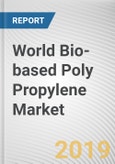Production of bio-based PP from sugarcane derived ethanol has already proved successful and is expected to witness widespread commercialization in the foreseeable future. Chemical companies are beginning to comprehend the tremendous growth potential that lies in bio-based PP and are anticipated to start production in the near future. Dow Chemicals and Braskem- both, giants of the chemical industry- have invested heavily in developing novel technologies for the production of PP from renewable sources. These initiatives, taken by industry frontrunners, clearly indicate that there will be mass production of bio-based PP in the foreseeable future. Braskem has set up a bio-polyethylene facility for the production of bio-polypropylene at Rio Grande do Sul, Brazil. The production capacity of this plant is in the range of 30 kilo tons to 50 kilo tons; it is expected to strategically target the packaging industry. As per an announcement made by the company, it will be manufacturing various grades of bio-based PP suitable for specific applications. The present production capacity of the company is estimated at nearly 50 kilo tons.
KEY BENEFITS
Analysis of the bio-based polypropylene market based on various geographies is expounded in the report
Identification of the various factors that are enhancing and restraining adoption bio-based PP would help the market players in understanding the current market scenario and future prospects
Qualitative as well as quantitative analysis of the current market scenario coupled with future estimations through 2014-2020 would help stakeholders take strategic, actionable and profitable decisions
Strategic analysis of future prospects of bio-based PP in developing nations would assist in taking region specific decisions
Porter’s five forces model helps to understand the bargaining power of buyers and suppliers and threat of the new entrants
Identification and analysis of the captivating strategies adopted by key market players would give competitive advantage to the stake holders
Methodology
The analyst offers exhaustive research and analysis based on a wide variety of factual inputs, which largely include interviews with industry participants, reliable statistics, and regional intelligence. The in-house industry experts play an instrumental role in designing analytic tools and models, tailored to the requirements of a particular industry segment. The primary research efforts include reaching out participants through mail, tele-conversations, referrals, professional networks, and face-to-face interactions.
They are also in professional corporate relations with various companies that allow them greater flexibility for reaching out to industry participants and commentators for interviews and discussions.
They also refer to a broad array of industry sources for their secondary research, which typically include; however, not limited to:
- Company SEC filings, annual reports, company websites, broker & financial reports, and investor presentations for competitive scenario and shape of the industry
- Scientific and technical writings for product information and related preemptions
- Regional government and statistical databases for macro analysis
- Authentic news articles and other related releases for market evaluation
- Internal and external proprietary databases, key market indicators, and relevant press releases for market estimates and forecast
Furthermore, the accuracy of the data will be analyzed and validated by conducting additional primaries with various industry experts and KOLs. They also provide robust post-sales support to clients.

LOADING...








